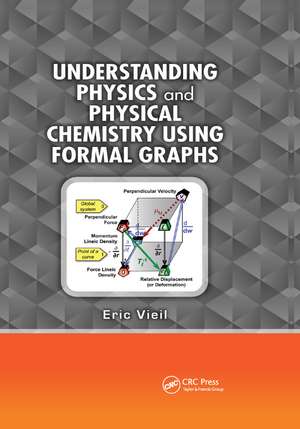Understanding Physics and Physical Chemistry Using Formal Graphs
Autor Eric Vieilen Limba Engleză Paperback – 8 noi 2018
Understanding Physics and Physical Chemistry Using Formal Graphs is organized according to the structures emerging from formal graphs, from simple to elaborate, providing after each series of case studies the theoretical elements necessary for understanding their common features. More than 80 case studies are tackled in domains ranging from translational mechanics to Newtonian gravitation to chemical reactions.
With the help of this new tool, the modeling of physical phenomena becomes a fascinating cross-disciplinary exploration. The graphs encourage a visual, unified comprehension of the relationships between physical concepts and variables, properties, and operators. Out-of-the-box and thought provoking, this book inspires lively discussions and fruitful thinking about the connections between mechanics, chemical reactivity, electrodynamics, thermodynamics, and more.
Preț: 352.95 lei
Preț vechi: 454.60 lei
-22% Nou
Puncte Express: 529
Preț estimativ în valută:
67.55€ • 69.62$ • 57.03£
67.55€ • 69.62$ • 57.03£
Carte tipărită la comandă
Livrare economică 01-15 martie
Preluare comenzi: 021 569.72.76
Specificații
ISBN-13: 9781138381438
ISBN-10: 1138381438
Pagini: 816
Ilustrații: approx 1222 equations; 226 Tables, black and white; 680 Illustrations, black and white
Dimensiuni: 178 x 254 x 49 mm
Greutate: 0.45 kg
Ediția:1
Editura: CRC Press
Colecția CRC Press
ISBN-10: 1138381438
Pagini: 816
Ilustrații: approx 1222 equations; 226 Tables, black and white; 680 Illustrations, black and white
Dimensiuni: 178 x 254 x 49 mm
Greutate: 0.45 kg
Ediția:1
Editura: CRC Press
Colecția CRC Press
Public țintă
ProfessionalCuprins
Introduction. Nodes of Graphs. Links and Organization. Poles. Space Distributed Poles. Dipoles. Influence between Poles. Multipoles. Dipole Assemblies. Transfers. Assemblies and Dissipation. Coupling between Energy Varieties. Multiple Couplings. Conclusion and Perspectives. Appendices. References. Index.
Notă biografică
Dr. Eric Vieil is a researcher in physical chemistry at the French Atomic Energy Agency (CEA) in Grenoble, France. He is a specialist with more than 80 publications in theoretical and experimental studies on the electrochemical mechanisms of conducting materials.
Recenzii
Vieil presents a universal toolkit—Formal Graphs—for understanding a wide range of scientific domains. … mainly for graduate students, researchers and specialists, and engineers; the process itself would even be accessible to undergraduate students … . The disk contains all the graphs, in color bitmap files, and software for building simple electric circuits and translating them into Formal Graphs.
—SciTech News, Vol. 66, September 2012
Vieil (French Atomic Energy Agency) discusses the use of formal graphs in physics and chemistry to facilitate an understanding of these subjects. This method has four primary purposes. First, pedagogically, students can benefit from considering theoretical systems in a non-algebraic way. With pictorial representations, students can more easily see relationships between elements of a theory and the similarities of formal graph structures among theories. Second, since formal graphs are neural networks, it is much easier to translate the science into algorithms if one starts with the graphs. Third, scientists already familiar with one area can more easily learn and gain insight into a new area that is using the same formal graph. Finally, researchers can benefit by examining the work of researchers in other disciplines that are considering the same formal graphs. This is an intriguing way to represent the science. The author provides more than 80 case studies to illustrate this method. A companion CD-ROM includes all of the book's formal graphs as well as software for translating simple examples into formal graphs. The related website contains a variety of supplementary materials. Recommended.
—E. Kincanon, Gonzaga University, CHOICE, August 2012
—SciTech News, Vol. 66, September 2012
Vieil (French Atomic Energy Agency) discusses the use of formal graphs in physics and chemistry to facilitate an understanding of these subjects. This method has four primary purposes. First, pedagogically, students can benefit from considering theoretical systems in a non-algebraic way. With pictorial representations, students can more easily see relationships between elements of a theory and the similarities of formal graph structures among theories. Second, since formal graphs are neural networks, it is much easier to translate the science into algorithms if one starts with the graphs. Third, scientists already familiar with one area can more easily learn and gain insight into a new area that is using the same formal graph. Finally, researchers can benefit by examining the work of researchers in other disciplines that are considering the same formal graphs. This is an intriguing way to represent the science. The author provides more than 80 case studies to illustrate this method. A companion CD-ROM includes all of the book's formal graphs as well as software for translating simple examples into formal graphs. The related website contains a variety of supplementary materials. Recommended.
—E. Kincanon, Gonzaga University, CHOICE, August 2012
Descriere
This book introduces a new graphs-based language called Formal Graphs for representing the mathematical equations found in a large number of scientific domains, including mechanics, physical chemistry, dynamics, solid state physics, rheology, surface energy, electrochemistry, and chemical reactivity. This elementary approach consists of drawing links and nodes on a graph, instead of writing algebraic equations. The graphs encourage a visual, unified comprehension of the relationships between physical concepts and variables, properties, and operators.
